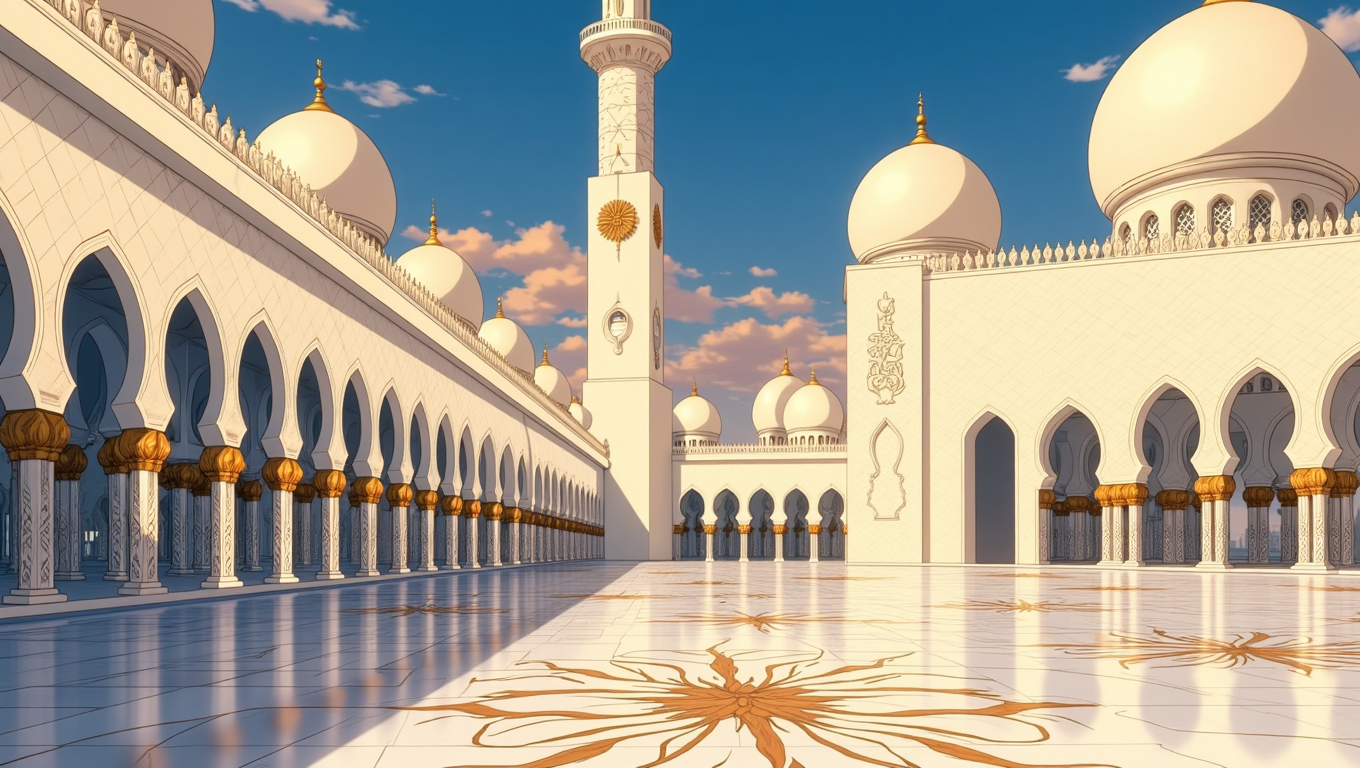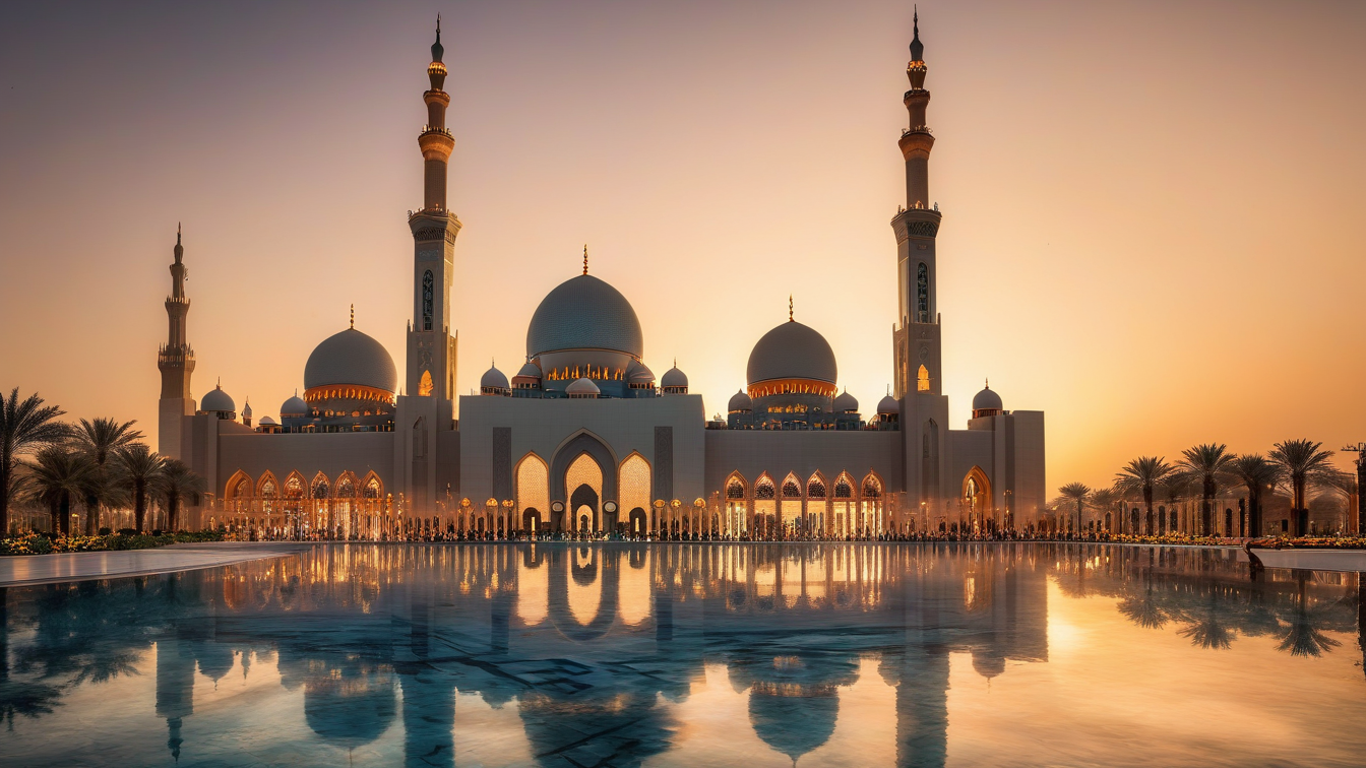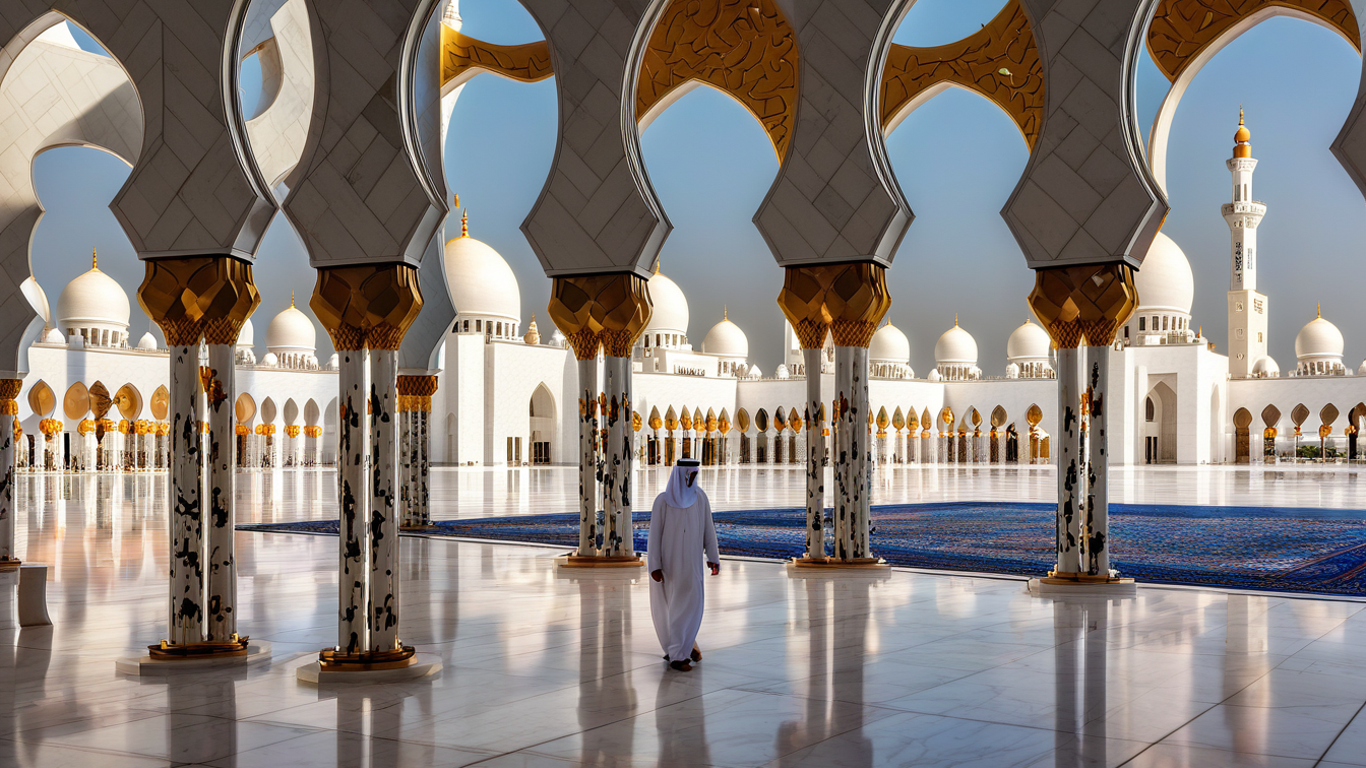 Religious Places
Religious Places
Jumeirah Mosque: Dubai's Crown Jewel of Islamic Architecture and Cultural Understanding
Step into a world where faith meets artistry, where ancient traditions welcome modern minds, and where the "Open Doors, Open Minds" philosophy creates bridges between cultures
A Sacred Welcome: Where Every Door Opens to Understanding
As the early morning call to prayer echoes across Dubai's bustling streets, there stands a magnificent ivory beacon that has been quietly revolutionizing cultural understanding for over two decades. Jumeirah Mosque, with its twin minarets reaching toward the heavens and its pristine white stone facade gleaming against the azure Arabian sky, represents far more than architectural magnificence – it embodies the very soul of tolerance and cultural exchange that defines modern Dubai.
Picture yourself walking along the palm-lined Jumeirah Beach Road as the sun casts long shadows across this medieval Fatimid masterpiece. The gentle sound of water features mingles with the distant murmur of the Arabian Gulf, while the mosque's elegant arches frame a scene that has captivated millions of visitors from every corner of the globe. This isn't just another landmark – this is where stories begin, where misconceptions dissolve, and where the beauty of Islamic culture unfolds through the Jumeirah Mosque experience.
A Vision Cast in Stone: The Remarkable History of Jumeirah Mosque
The story of Jumeirah Mosque begins in the mid-1970s with a vision that would forever change how the world perceived Islamic culture and Dubai's commitment to tolerance. Construction began in 1975 under the patronage of Sheikh Rashid bin Saeed Al Maktoum, and the mosque opened its doors for worship in 1979, marking not just the creation of a house of worship, but the birth of what would become Dubai's most significant cultural bridge.
• 1975: Construction begins under Sheikh Rashid bin Saeed Al Maktoum
• 1979: Mosque opens for prayers, accommodating 1,500 worshippers
• 1998: Revolutionary "Open Doors, Open Minds" program launches
• 2003: Featured on the AED 500 dirham note (later replaced by Burj Khalifa)
• Present: Over two decades of cultural exchange and understanding
The mosque was designed by architects Abd al-Muʿizz Husayn and Muhammad al-Mahdi Hegazy of Hegazy Engineering Consultancy, who created this masterpiece as a gift from Sheikh Rashid to his son, Sheikh Mohammed bin Rashid Al Maktoum. What makes this story particularly touching is how this personal gesture between father and son would later become a global symbol of cultural openness and understanding.
The decision to open Jumeirah Mosque to non-Muslim visitors in 1998 was revolutionary in the region. Under the banner of 'Open Doors. Open Minds,' the mosque became the flagship program of The Sheikh Mohammed bin Rashid Al Maktoum Centre for Cultural Understanding, transforming what was purely a place of worship into a living classroom where cultures meet, questions are welcomed, and understanding flourishes.
Architectural Poetry: The Fatimid Masterpiece Unveiled
The Language of Stone and Light
Built entirely from pure-white stone in the traditional Fatimid style that originates from Egypt and Syria, Jumeirah Mosque showcases intricate geometric designs, Arabic calligraphy, and distinctive keel motifs on its domes. The building stands as a perfect example of how ancient Islamic architectural traditions can create timeless beauty that transcends cultural boundaries.
The mosque's design represents a harmonious blend of Fatimid and Mamluk architectural influences, creating a unique aesthetic that honors multiple Islamic architectural traditions. Known as the 'two minaret mosque,' its twin minarets frame a magnificent central dome, creating a composition that photographers and artists have celebrated for decades.
As you approach Jumeirah Mosque, the first thing that strikes you is its ethereal quality – especially during the golden hour when the setting sun transforms the white stone into a canvas of warm, honey-colored light. The mosque features Fatimid inscriptions in the Arabesque style, with domes made of glass fibre reinforced concrete (GRC) to favor the intricate inscriptions.
The interior reveals even greater treasures. Step inside to the main prayer hall, and you'll be mesmerized by elegant arches and columns, plush green carpet, and stained glass windows. The peach and blue ceilings are inscribed with verses from the Holy Quran, creating an atmosphere of profound serenity and spiritual reflection.
Sacred Geometry and Divine Proportions
Every element of Jumeirah Mosque has been carefully planned according to Islamic architectural principles. The mihrab – the prayer niche indicating the direction of Mecca – serves as the spiritual focal point, while the elegant chandeliers reflect the Islamic tradition of incorporating artistic beauty into sacred spaces.
The mosque is mostly painted in light blue and other colors that distinguish Fatimid mosques, creating a color palette that evokes both the sky above and the tranquil waters of the Arabian Gulf nearby.
The Open Doors, Open Minds Experience: A Journey of Discovery
More Than a Tour: A Cultural Awakening
The Jumeirah Mosque guided tour represents something unprecedented in the region – a genuine invitation for people of all faiths to step inside an active mosque and experience Islamic culture firsthand. Over the last two decades, guests have consistently voted this as their favorite cultural activity in the United Arab Emirates.
Tours are led by individual Muslim guides of varying national and ethnic backgrounds, covering topics including the Five Pillars of Islam, ablution procedures, and the basics of Islamic prayer, concluding with an interactive Q&A session.
Your journey begins in the traditional majlis – a welcoming space that embodies the Arab tradition of hospitality. Here, you'll be offered authentic Emirati refreshments including Arabic coffee, tea, and dates, while learning about the cultural significance of these time-honored traditions. This isn't merely a tourist experience; it's an authentic cultural exchange that reflects the genuine warmth of Emirati hospitality.
• Interactive demonstrations of Islamic prayer and ablution rituals
• Opportunity to ask any questions about Islam and Arab culture
• Photography permitted throughout the tour
• Traditional Emirati refreshments included
• No pressure or proselytizing – purely educational focus
• Guides from diverse backgrounds share personal perspectives
The tour's educational component goes far beyond basic facts about Islamic architecture. Visitors learn about the daily lives of Muslims, the significance of the Five Pillars of Islam, and how faith integrates into contemporary life in the UAE. The Q&A sessions often become the most memorable part of the experience, as visitors feel free to ask questions that they might never have had the opportunity to explore elsewhere.
Planning Your Spiritual and Cultural Journey
Essential Visiting Information
Guided tours are offered daily except Friday at 10:00 AM and 2:00 PM, with registration opening 30 minutes before each tour begins. The tour fee is AED 25 for adults, with children under 12 visiting free, and no advance booking is required – though arriving 15 minutes early is recommended.
Location: Jumeirah Beach Road, Jumeirah 1, Dubai
Contact: +971 4 353 6666
Website: www.jumeirahmosque.ae
Dress Code and Cultural Sensitivity
Visiting Jumeirah Mosque requires modest attire that respects Islamic traditions. For both men and women, clothing should cover shoulders and knees. Women must also cover their heads with a scarf. The mosque provides traditional clothing including abayas, kandoras, and headscarves for visitors who need them.
This dress code isn't merely about rules – it's about showing respect for a sacred space and the people who worship there. Many visitors find that wearing traditional Emirati clothing enhances their cultural experience and creates wonderful photo opportunities.
Best Times to Visit
While Jumeirah Mosque is stunning at any time of day, certain moments offer particularly magical experiences. The morning tour (10:00 AM) provides comfortable temperatures and beautiful natural lighting for photography. However, many photographers and cultural enthusiasts prefer visiting during the late afternoon when the setting sun illuminates the white stone facade, creating an almost mystical glow.
During Ramadan, the mosque takes on special significance as a center for community gatherings and nightly prayers. While tour schedules may be adjusted during this holy month, the atmosphere becomes particularly spiritual and meaningful.
Beyond the Mosque: Exploring Jumeirah's Cultural Landscape
Your visit to Jumeirah Mosque places you in the heart of one of Dubai's most culturally rich neighborhoods. The surrounding Jumeirah area offers numerous opportunities to extend your cultural exploration and create a full day of meaningful experiences.
Just a short walk away, you'll find the vibrant Dubai Mall, where traditional souks meet modern luxury retail. The nearby Iranian Mosque offers another perspective on Islamic architecture, while the bustling Gold and Spice Souks provide authentic marketplace experiences that haven't changed for generations.
• Iranian Mosque (7-minute walk) - Traditional Iranian tile architecture
• La Mer Beach - Modern beachfront development with cultural events
• Jumeirah Open Beach - Public beach perfect for reflection
• Mercato Mall - Shopping with Tuscan-inspired architecture
• Traditional cafes along Jumeirah Beach Road
The Living Legacy: How Jumeirah Mosque Shapes Modern Dubai
Jumeirah Mosque represents more than historical significance – it actively shapes Dubai's identity as a global city that celebrates diversity while honoring its roots. The mosque serves as a model for how traditional Islamic values can coexist with modern cosmopolitan life, creating a template that influences Dubai's approach to cultural integration.
A Bridge Between Worlds
The mosque's impact extends far beyond its physical boundaries. Through its educational programs, cultural meals, and corporate workshops, Jumeirah Mosque has trained thousands of expatriate residents and international visitors in cultural sensitivity and understanding.
Many multinational companies based in Dubai now include visits to Jumeirah Mosque as part of their employee orientation programs, recognizing that cultural understanding enhances both personal relationships and business success in this diverse city.
Photographer's Paradise: Capturing Timeless Beauty
Few landmarks in Dubai offer the photographic opportunities that Jumeirah Mosque provides. Widely regarded as one of the most photographed mosques in Dubai, it offers stunning compositions whether you're using a professional camera or a smartphone.
The interplay of light and shadow across the white stone facade creates different moods throughout the day. Early morning light emphasizes the mosque's serene, contemplative qualities, while sunset photography captures its more dramatic and mystical aspects. The surrounding landscaping, with its carefully maintained gardens and water features, provides beautiful foreground elements for wide-angle compositions.
During the guided tour, photography is not only permitted but encouraged. Visitors often discover that their most meaningful photos aren't just of the architecture, but of the moments of cultural exchange – conversations with guides, fellow visitors from different cultures sharing experiences, and the genuine smiles that come from newfound understanding.
Special Events and Seasonal Celebrations
Throughout the year, Jumeirah Mosque becomes a focal point for various cultural celebrations and educational events. During the UAE's Year of Tolerance initiatives, the mosque hosted special programs highlighting the country's commitment to religious diversity and cultural understanding.
The holy month of Ramadan transforms the mosque into a hub of community activity. While regular tourist tours may be adjusted, special Ramadan programs often provide unique insights into Islamic traditions and the spiritual significance of this sacred time. The evening iftar gatherings create opportunities for visitors to experience authentic Emirati hospitality at its finest.
Transportation and Accessibility
Reaching Jumeirah Mosque is straightforward from anywhere in Dubai. Taxi is the most convenient option, with typical rides from central Dubai taking 15-20 minutes and costing approximately $5 USD. For those preferring public transportation, several bus routes (12, 8, 88, C10, X28) serve the area, with the nearest stop being Palm Strip Center – just 2 minutes away.
For visitors driving, free parking is available across from the mosque, making it easily accessible for those exploring Dubai independently. The mosque's location on Jumeirah Beach Road also makes it an perfect stop during scenic drives along Dubai's coastline.
The Global Impact of Local Understanding
The success of Jumeirah Mosque's cultural program has inspired similar initiatives worldwide. Its model of "Open Doors, Open Minds" has been studied and adapted by cultural organizations globally, proving that authentic cultural exchange creates lasting positive impact far beyond geographical boundaries.
Visitors often report that their experience at Jumeirah Mosque fundamentally changed their understanding not just of Islam, but of the importance of cultural dialogue in our interconnected world. These personal transformations multiply as visitors return home and share their experiences, creating ripple effects of understanding that extend far beyond Dubai's borders.
A Living Monument to Tolerance
In a world often divided by misunderstanding and prejudice, Jumeirah Mosque stands as a beacon of what's possible when communities choose dialogue over division. Its Fatimid architecture may be rooted in medieval traditions, but its message is thoroughly modern: that beauty, wisdom, and understanding transcend all boundaries of faith, nationality, and culture.
For comprehensive information about Dubai's attractions and planning your visit, consult the official Google Travel guide for Dubai, which provides current information about touring schedules, nearby attractions, and transportation options.
Your Journey of Understanding Awaits
Whether you're seeking architectural inspiration, cultural enlightenment, spiritual reflection, or simply a deeper understanding of the Islamic faith and Emirati culture, Jumeirah Mosque offers an experience that will enrich your perspective and create lasting memories.
In a city known for breaking records and pushing boundaries, Jumeirah Mosque achieves something even more remarkable – it builds bridges between hearts and minds, one visitor at a time.
Have you visited Jumeirah Mosque? Share your experience and help other travelers discover the beauty of cultural understanding! What aspects of Islamic culture or architecture intrigued you most during your visit?




Comments (0)
{{ obj.comment_user_info.fullname }}
{{ obj.date_formatted }}{{ expandedComments[index] ? obj.comment : obj.comment.slice(0, 50) + (obj.comment.length > 50 ? '...' : '') }}
Add Comments
Login to comment